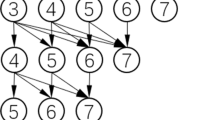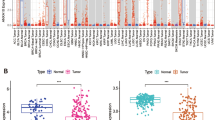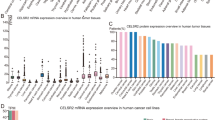Abstract
ITGA2 (Integrin alpha-2) has been detected to be over-expressed in a number of cancers and has been suggested to be involved in cell adhesion and cell-surface mediated signaling. Our previous study using bioinformatic analyses has shown that ITGA2 might be a key gene being involved in the Cadmium-induced malignant transformation of liver cells. In the present study, we firstly aimed to learn the possible functions of ITGA2 via bioinformatics analysis, and then test its expression and clinical significance in liver carcinoma specimens through laboratory experiments. Gene ontology (GO) and pathway enrichment analysis, as well as protein-protein interaction (PPI) analysis has been conducted in Genecards. Then, a tissue microarray containing 90 cases of liver cancer and 90 paired adjacent non-cancerous samples was used for detection of ITGA2 expression by immunohistochemistry assay. Consequently, ITGA2 may be enriched in pathways regarding cell adhesion and migration. PPI analysis suggests that ITGA1, ITGB2, FLT4, LAMB1 and AGRN may have a close relationship with ITGA2. No association between ITGA2 expression and clinical parameters was observed. However, the data showed that ITGA2 might be an independent prognostic factor for liver cancer patients. In conclusion, the data suggest that ITGA2 over-expression might be a potential unfavorable prognostic factor and a potential therapeutic target for liver carcinoma.



Similar content being viewed by others
References
Satarug S, Vesey DA, Gobe GC (2017) Current health risk assessment practice for dietary cadmium: data from different countries. Food Chem Toxicol 106(Pt A):430–445. https://doi.org/10.1016/j.fct.2017.06.013
Sabolic I, Breljak D, Skarica M, Herak-Kramberger CM (2010) Role of metallothionein in cadmium traffic and toxicity in kidneys and other mammalian organs. Biometals 23(5):897–926. https://doi.org/10.1007/s10534-010-9351-z
Cartularo L, Kluz T, Cohen L, Shen SS, Costa M (2016) Molecular mechanisms of malignant transformation by low dose cadmium in Normal human bronchial epithelial cells. PLoS One 11(5):e0155002. https://doi.org/10.1371/journal.pone.0155002
Garcia-Esquinas E, Pollan M, Tellez-Plaza M, Francesconi KA, Goessler W, Guallar E, Umans JG, Yeh J, Best LG, Navas-Acien A (2014) Cadmium exposure and cancer mortality in a prospective cohort: the strong heart study. Environ Health Perspect 122(4):363–370. https://doi.org/10.1289/ehp.1306587
Ledda C, Loreto C, Zammit C, Marconi A, Fago L, Matera S, Costanzo V, Fuccio Sanza G, Palmucci S, Ferrante M, Costa C, Fenga C, Biondi A, Pomara C, Rapisarda V (2017) Noninfective occupational risk factors for hepatocellular carcinoma: a review (review). Mol Med Rep 15(2):511–533. https://doi.org/10.3892/mmr.2016.6046
Ma X, Yang Y, Li HL, Zheng W, Gao J, Zhang W, Yang G, Shu XO, Xiang YB (2017) Dietary trace element intake and liver cancer risk: results from two population-based cohorts in China. Int J Cancer 140(5):1050–1059. https://doi.org/10.1002/ijc.30522
Stelzer G, Rosen N, Plaschkes I, Zimmerman S, Twik M, Fishilevich S, Stein TI, Nudel R, Lieder I, Mazor Y, Kaplan S, Dahary D, Warshawsky D, Guan-Golan Y, Kohn A, Rappaport N, Safran M, Lancet D (2016) The GeneCards suite: from gene data mining to disease genome sequence analyses. Curr Protoc Bioinformatics 54(1):30 31–31 30 33. https://doi.org/10.1002/cpbi.5
Mo Z, Zheng S, Lv Z, Zhuang Y, Lan X, Wang F, Lu X, Zhao Y, Zhou S (2016) Senescence marker protein 30 (SMP30) serves as a potential prognostic indicator in hepatocellular carcinoma. Sci Rep 6:39376. https://doi.org/10.1038/srep39376
Yang Q, Bavi P, Wang JY, Roehrl MH (2017) Immuno-proteomic discovery of tumor tissue autoantigens identifies olfactomedin 4, CD11b, and integrin alpha-2 as markers of colorectal cancer with liver metastases. J Proteome 168:53–65. https://doi.org/10.1016/j.jprot.2017.06.021
Dong J, Wang R, Ren G, Li X, Wang J, Sun Y, Liang J, Nie Y, Wu K, Feng B, Shang Y, Fan D (2017) HMGA2-FOXL2 Axis regulates metastases and epithelial-to-mesenchymal transition of chemoresistant gastric cancer. Clin Cancer Res 23(13):3461–3473. https://doi.org/10.1158/1078-0432.CCR-16-2180
Ding W, Fan XL, Xu X, Huang JZ, Xu SH, Geng Q, Li R, Chen D, Yan GR (2015) Epigenetic silencing of ITGA2 by MiR-373 promotes cell migration in breast cancer. PLoS One 10(8):e0135128. https://doi.org/10.1371/journal.pone.0135128
Wong KF, Liu AM, Hong W, Xu Z, Luk JM (2016) Integrin alpha2beta1 inhibits MST1 kinase phosphorylation and activates Yes-associated protein oncogenic signaling in hepatocellular carcinoma. Oncotarget 7(47):77683–77695. https://doi.org/10.18632/oncotarget.12760
Zhao X, Wu Y, Lv Z (2015) miR-128 modulates hepatocellular carcinoma by inhibition of ITGA2 and ITGA5 expression. Am J Transl Res 7(9):1564–1573
Chin SP, Marthick JR, West AC, Short AK, Chuckowree J, Polanowski AM, Thomson RJ, Holloway AF, Dickinson JL (2015) Regulation of the ITGA2 gene by epigenetic mechanisms in prostate cancer. Prostate 75(7):723–734. https://doi.org/10.1002/pros.22954
Gharibi A, La Kim S, Molnar J, Brambilla D, Adamian Y, Hoover M, Hong J, Lin J, Wolfenden L, Kelber JA (2017) ITGA1 is a pre-malignant biomarker that promotes therapy resistance and metastatic potential in pancreatic cancer. Sci Rep 7(1):10060. https://doi.org/10.1038/s41598-017-09946-z
Laskowska J, Lewandowska-Bieniek J, Szczepanek J, Styczynski J, Tretyn A (2016) Genomic and transcriptomic profiles and in vitro resistance to mitoxantrone and idarubicin in pediatric acute leukemias. J Gene Med 18(8):165–179. https://doi.org/10.1002/jgm.2889
Lee JY, Hong SH, Shin M, Heo HR, Jang IH (2016) Blockade of FLT4 suppresses metastasis of melanoma cells by impaired lymphatic vessels. Biochem Biophys Res Commun 478(2):733–738. https://doi.org/10.1016/j.bbrc.2016.08.017
Virga J, Bognar L, Hortobagyi T, Zahuczky G, Csosz E, Kallo G, Toth J, Hutoczki G, Remenyi-Puskar J, Steiner L, Klekner A (2017) Prognostic role of the expression of invasion-related molecules in Glioblastoma. J Neurol Surg A Cent Eur Neurosurg 78(1):12–19. https://doi.org/10.1055/s-0036-1584920
Lin Q, Lim HS, Lin HL, Tan HT, Lim TK, Cheong WK, Cheah PY, Tang CL, Chow PK, Chung MC (2015) Analysis of colorectal cancer glyco-secretome identifies laminin beta-1 (LAMB1) as a potential serological biomarker for colorectal cancer. Proteomics 15(22):3905–3920. https://doi.org/10.1002/pmic.201500236
Chakraborty S, Lakshmanan M, Swa HL, Chen J, Zhang X, Ong YS, Loo LS, Akincilar SC, Gunaratne J, Tergaonkar V, Hui KM, Hong W (2015) An oncogenic role of Agrin in regulating focal adhesion integrity in hepatocellular carcinoma. Nat Commun 6:6184. https://doi.org/10.1038/ncomms7184
Chakraborty S, Njah K, Pobbati AV, Lim YB, Raju A, Lakshmanan M, Tergaonkar V, Lim CT, Hong W (2017) Agrin as a Mechanotransduction signal regulating YAP through the hippo pathway. Cell Rep 18(10):2464–2479. https://doi.org/10.1016/j.celrep.2017.02.041
Author information
Authors and Affiliations
Contributions
LZ and YZ designed the study and reviewed the manuscript. YH, JL and WZ performed the bioinformatics analysis and immunohistochemical staining. LZ, ZY and YL analysed the data. LZ, WL, and YZ wrote the manuscript.
Corresponding author
Ethics declarations
The experiments reported here were carried out according to the Declaration of Helsinki principles and the institute’s ethical regulations.
Conflict of Interest
The authors declare that they have no conflict of interest.
Additional information
Publisher’s Note
Springer Nature remains neutral with regard to jurisdictional claims in published maps and institutional affiliations.
Rights and permissions
About this article
Cite this article
Zhang, L., Huang, Y., Ling, J. et al. Is Integrin Subunit Alpha 2 Expression a Prognostic Factor for Liver Carcinoma? A Validation Experiment Based on Bioinformatics Analysis. Pathol. Oncol. Res. 25, 1545–1552 (2019). https://doi.org/10.1007/s12253-018-0551-0
Received:
Accepted:
Published:
Issue Date:
DOI: https://doi.org/10.1007/s12253-018-0551-0




